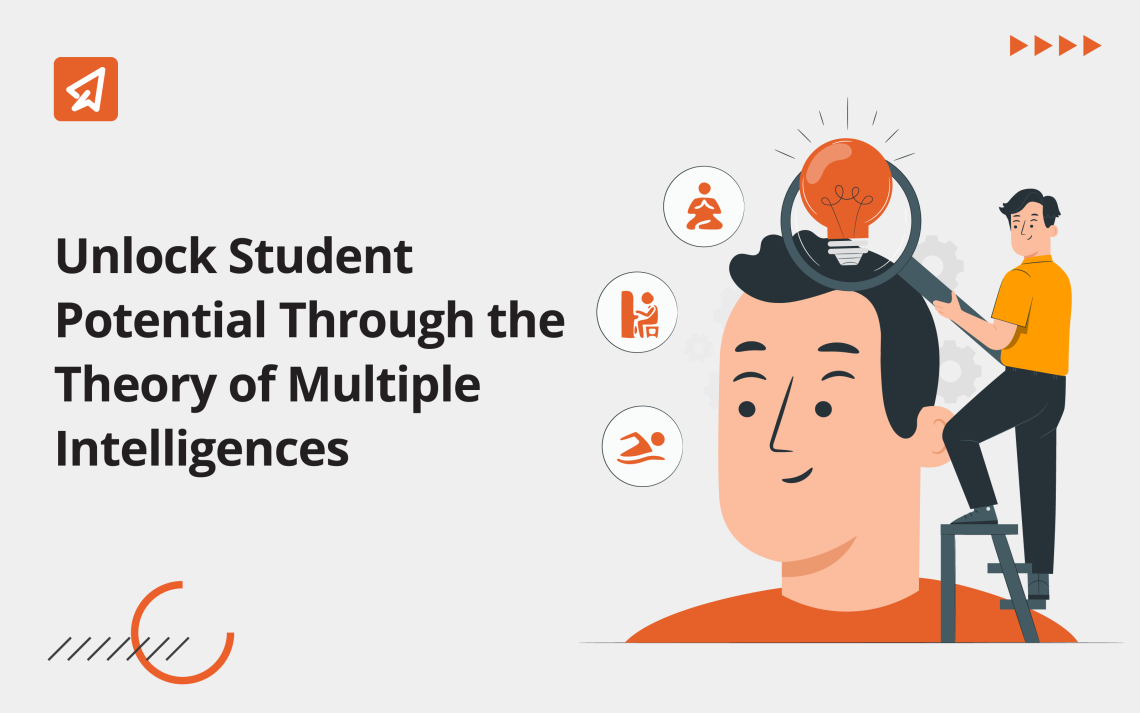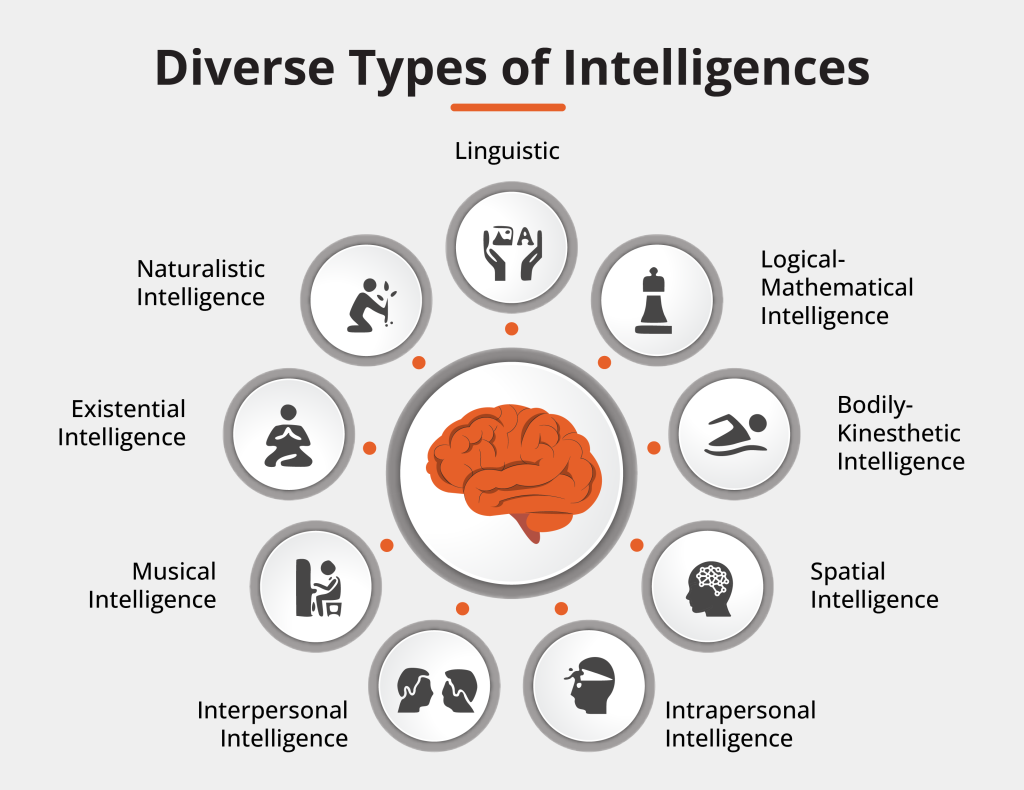Unlock Student Potential Through the Theory of Multiple Intelligences

Teachers play a crucial role in shaping young minds and facilitating their academic journey. Understanding the diverse ways in which students perceive and process information can greatly improve an educator’s performance. One theory that can shed light on these individual differences is the theory of multiple intelligences. In this blog, we will explore Howard Gardner’s theory of multiple intelligences, the nine distinct intelligences as described by the theory, and how teachers can benefit from this knowledge in their classrooms.
Theory of Multiple Intelligences – What You Can Learn From It As A Teacher
Howard Gardner’s theory of multiple intelligences provides valuable insights into the diverse ways in which students learn and excel. By recognizing and addressing these individual differences, you can cater to diverse learning styles and enhance student engagement. Incorporating this knowledge into your teaching practices can help you create an inclusive learning environment that supports your students’ growth.
What is the Multiple Intelligences Theory?
The theory of multiple intelligences suggests that intelligence is not a singular characteristic but rather a collection of different abilities that individuals possess to varying degrees. According to this theory, each person has a unique combination of intelligences, which can be nurtured and developed. The theory postulates that understanding which type of intelligence a student possesses can help teachers adapt their teaching style to their students’ needs and suggest the right career paths for them.
Howard Gardner’s Theory of Multiple Intelligences

Howard Gardner’s theory of multiple intelligence identifies nine different intelligences, each representing a different way of processing information and understanding the world. Let us understand each of these intelligences.
1. Linguistic Intelligence
Individuals with linguistic intelligence excel in reading, writing, and verbal communication. They have a strong command over languages and are skilled in expressing their thoughts and ideas. They possess a rich vocabulary and a knack for storytelling, making them excellent writers, poets, journalists, and orators. This gift for linguistic expression enables them to articulate complex concepts and engage others in meaningful conversations.
2. Logical-Mathematical Intelligence
Logical-mathematical intelligence refers to the ability to think logically, reason, and solve complex problems. People with this intelligence possess exceptional analytical and critical thinking skills. They have a natural affinity for numbers, patterns, and logical sequences. They thrive in fields such as mathematics, computer science, engineering, and research.
3. Spatial Intelligence
Spatial intelligence involves the ability to think and visualize in three dimensions. Individuals with spatial intelligence have a keen sense of spatial relationships, which helps them excel in fields such as architecture, design, engineering, and art. They can mentally manipulate and transform objects in their minds, effortlessly understanding and creating visual representations.
4. Bodily-Kinesthetic Intelligence
Bodily-kinesthetic intelligence relates to the ability to control one’s body movements and handle objects skillfully. People with this intelligence often possess remarkable physical coordination, dexterity, and agility. They excel in activities such as sports, dance, martial arts, and acting. They also become adept at communicating their emotions through their movements.
5. Musical Intelligence
Musical intelligence involves a strong sensitivity to rhythm, pitch, melody, and sound. Individuals with this intelligence are naturally inclined towards music and often demonstrate exceptional musical abilities. They possess a keen ear for tones, harmonies, and patterns in music, allowing them to effortlessly create, perform, and appreciate music.
6. Interpersonal Intelligence
Interpersonal intelligence refers to the ability to understand and interact effectively with others. People with this intelligence have strong social skills, empathy, and emotional intelligence. They excel in forging meaningful connections, building relationships, and effectively communicating with individuals from diverse backgrounds.
7. Intrapersonal Intelligence
Intrapersonal intelligence relates to self-awareness and understanding one’s own emotions, strengths, and weaknesses. Individuals with this intelligence have a deep sense of self and are skilled at introspection. They excel in setting personal goals, managing their emotions, and maintaining a strong sense of identity.
8. Naturalistic Intelligence
Naturalistic intelligence involves a deep connection and understanding of the natural world. Individuals with this intelligence possess an innate appreciation for the environment, flora, and fauna. They excel in activities such as gardening, animal care, environmental science, and ecology.
9. Existential Intelligence
Existential intelligence refers to the ability to contemplate and ponder over existential questions about life, death, and the universe. Individuals with this intelligence often have a philosophical or spiritual inclination. They excel in exploring philosophical concepts, engaging in introspection, and reflecting on life’s fundamental mysteries.
How Do Teachers Benefit from Understanding Multiple Intelligences?
By familiarizing themselves with the theory of multiple intelligences, teachers can ensure that they adapt their teaching style to meet their students’ individual needs and ensure optimum academic outcomes. Let us explore some of the key benefits for educators.
1. Catering to Diverse Learning Styles
Each student possesses a unique combination of intelligences. By recognizing and addressing these differences, teachers can design lessons that cater to various learning styles, ensuring that every student has the opportunity to thrive.
This can be a challenging process which can be supported with the use of platforms like Extramarks Smart Class Plus, a 360 degree school solutions platform., Using their analytics dashboard, teachers can view recommendations for each individual student based on their past performance. It also offers interactive content and multimedia resources that cater to different intelligences.
2. Enhancing Student Engagement
Understanding students’ intelligences allows teachers to design activities and projects that tap into their strengths and interests. This promotes higher levels of engagement and motivation among students, leading to a more productive learning experience. Teachers can engage their students further with Smart Class Plus features like gamification and interactive learning.
3. Fostering Collaboration and Teamwork
The theory of multiple intelligences emphasizes the importance of interpersonal intelligence which involves effective communication and collaboration. Teachers can encourage group activities and projects that allow students to leverage their interpersonal intelligence and develop essential teamwork skills.
4. Nurturing Individual Talents
By identifying and nurturing students’ individual intelligences, teachers can help them discover and develop their unique talents. This approach fosters a sense of self-worth and encourages students to pursue their passions and interests.
Using Smart Class Plus, teachers can offer their students personalized learning pathways that allow students to explore subjects at their own pace and delve deeper into areas of their interest.
5. Promoting Holistic Development
By embracing the theory of multiple intelligences, teachers can adopt a holistic approach to education. This ensures that students’ cognitive, emotional, and social development is nurtured, leading to well-rounded individuals.
How to Identify the Dominant Intelligence of Each Student
Identifying the dominant intelligences of your students can be a challenging yet rewarding task. We have four strategies to help you correctly identify them:
1. Observation
Observe your students’ behavior, interests, and strengths during classroom activities and discussions. Look for patterns that indicate their preferred ways of learning and engaging with the content.
2. Self-Assessment
Encourage students to reflect on their own strengths and interests. Provide them with self-assessment tools or questionnaires that help them identify their dominant intelligences.
3. Project-Based Learning
Assign projects or activities that allow students to demonstrate their skills and intelligences. Observe their performance and interactions during these tasks to gain insights into their preferred intelligences.
4. Feedback and Dialogue
Engage in conversations with your students and provide them with constructive feedback. Ask them about their learning experiences and encourage them to share their preferred approaches to understanding and solving problems.
Challenges of Multiple Intelligences Theory
While the theory of multiple intelligences offers valuable insights into individual differences, it also has certain challenges. Critics argue that the theory lacks empirical evidence and that the intelligences needs further clarification. Additionally, implementing a curriculum that caters to multiple intelligences can be demanding for educators, requiring additional resources and planning.
However, despite these challenges, many teachers have found the theory of multiple intelligences to be a useful framework for designing inclusive and engaging learning experiences.
The theory of multiple intelligences provides a valuable perspective for teachers to understand and cater to the diverse needs of their students. By embracing this theory, educators can create inclusive classrooms that foster engagement, collaboration, and individual growth. By leveraging its insights and using innovative tools like the Extramarks Smart Class Plus platform, you can create an effective learning environment.
FAQs
Q1. Is intelligence fixed or can it be developed?
Ans. According to the theory of multiple intelligences, intelligence is not fixed and can be developed through nurturing and diverse learning experiences.
Q2. How can I integrate multiple intelligences into my teaching?
Ans. You can integrate multiple intelligences into your teaching by designing activities and assessments that tap into different intelligences. Providing varied resources and encouraging collaboration can also support the development of multiple intelligences in your students.
Q3. Are some intelligence more valuable than others?
Ans. No, all intelligence is equally valuable and important. The theory of multiple intelligences emphasizes the diversity of human abilities and the unique strengths that individuals possess. Each intelligence serves different purposes and contributes to a well-rounded society.
Last Updated on September 1, 2023









